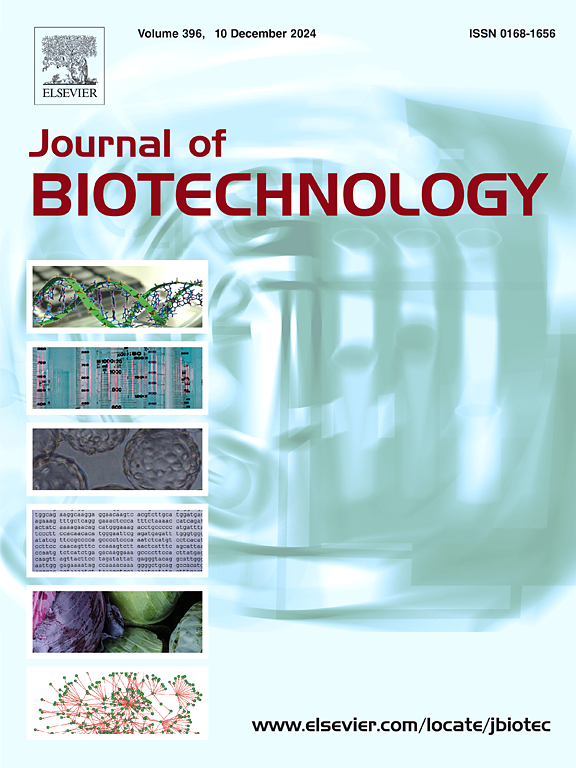新型聚半乳糖醛酸酶PG-BG31阻止生物膜的形成,提高抗生素对导管相关大肠杆菌的疗效
IF 3.9
2区 生物学
Q2 BIOTECHNOLOGY & APPLIED MICROBIOLOGY
引用次数: 0
摘要
大肠杆菌是尿路感染的主要原因,这在导尿患者中尤其成问题,因为形成的生物膜对标准治疗有耐药性。本研究研究了一种来自Pedobacter sp. BG31的新型聚半乳糖醛酸酶(PG-BG31)及其对来自尿路感染患者尿液的大肠杆菌分离株的抗生物膜性能。以聚半乳糖醛酸为底物对该酶进行了异种表达和生化表征。该酶表现出较强的生物膜抑制作用,BIC50值在2 ~ 5 µg/mL之间,随大肠杆菌菌株的不同而不同。它优于大肠杆菌生物膜研究中常用的酶,包括蛋白酶K、dna酶和纤维素酶。作为预处理时,在较低抗生素浓度下,环丙沙星和甲氧苄啶的生物膜形成减少了4 log(99.99 %),显著提高了其疗效。聚半乳糖醛酸酶PG-BG31在温度为25 °C - 42 °C和微酸性pH值(pH 5.0 - 6.0)下发挥最佳作用,pH值与尿液中的环境相对应。此外,该酶对培养细胞和秀丽隐杆线虫没有毒性。这些结果表明,聚半乳糖醛酸酶具有开发抗生物膜策略治疗导尿管相关尿路感染的潜力。本文章由计算机程序翻译,如有差异,请以英文原文为准。
Novel polygalacturonase PG-BG31 prevents biofilm formation and increases antibiotic efficacy against catheter-associated Escherichia coli
Escherichia coli is a leading cause of urinary tract infections, which are particularly problematic in catheterized patients due to the formation of biofilms that are resistant to standard treatments. Here we investigated a novel polygalacturonase (PG-BG31) from Pedobacter sp. BG31 and its anti-biofilm properties against E. coli isolates originating from the urine of UTI patients. The enzyme was heterologously expressed and biochemically characterized using polygalacturonic acid as substrate. The enzyme showed strong biofilm inhibition with BIC50 values between 2 and 5 µg/mL, which varied depending on the E. coli strain. It outperformed enzymes commonly used in E. coli biofilm studies, including proteinase K, DNase and cellulase. When used as a pretreatment, it significantly improved the efficacy of ciprofloxacin and trimethoprim by reducing biofilm formation by 4 log (99.99 %) at lower antibiotic concentrations. Polygalacturonase PG-BG31 works optimally at temperatures of 25 °C - 42 °C and a slightly acidic pH value (pH 5.0 – 6.0), which corresponds to the environment in urine. In addition, the enzyme showed no toxicity to cells in culture or C. elegans. These results suggest that polygalacturonase has the potential for the development of anti-biofilm strategies for catheter-related urinary tract infections.
求助全文
通过发布文献求助,成功后即可免费获取论文全文。
去求助
来源期刊

Journal of biotechnology
工程技术-生物工程与应用微生物
CiteScore
8.90
自引率
2.40%
发文量
190
审稿时长
45 days
期刊介绍:
The Journal of Biotechnology has an open access mirror journal, the Journal of Biotechnology: X, sharing the same aims and scope, editorial team, submission system and rigorous peer review.
The Journal provides a medium for the rapid publication of both full-length articles and short communications on novel and innovative aspects of biotechnology. The Journal will accept papers ranging from genetic or molecular biological positions to those covering biochemical, chemical or bioprocess engineering aspects as well as computer application of new software concepts, provided that in each case the material is directly relevant to biotechnological systems. Papers presenting information of a multidisciplinary nature that would not be suitable for publication in a journal devoted to a single discipline, are particularly welcome.
 求助内容:
求助内容: 应助结果提醒方式:
应助结果提醒方式:


